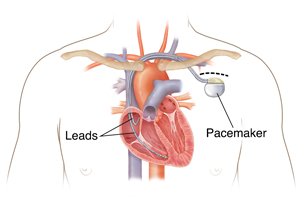Understanding Lead Extraction
Lead extraction is the removal of wires from your heart. The wires are part of an implanted cardiac device such as a pacemaker. This is a small machine put into your chest that helps your heart keep a normal rate and rhythm.
What are implanted cardiac devices?
Many people have implanted cardiac devices. These include pacemakers, implantable cardioverter defibrillators (ICDs), or a combination of both. Pacemakers can help treat slow heart rhythms. ICDs stop dangerous rapid heart rhythms.
Both pacemakers and ICDs have 2 main parts:
-
Pulse generator. This is a small computer with electric circuits and a battery that is implanted in the chest underneath the skin.
-
Leads. These are the wires that run between the pulse generator and your heart.
Leads can stay attached to the heart permanently. But in some cases, they need to be removed. This is called lead extraction.

Why lead extraction is done
The most common reasons for lead extraction include:
-
Infection of any part of the cardiac device
-
Infection of a heart valve
-
Broken or malfunctioning leads
Other reasons for lead extraction are less common. These include:
-
Dangerous leads (such as a protruding wire)
-
Recall on a certain type of defective pacemaker or ICD lead
-
Blood clot or scar tissue on a lead that blocks a vein
-
A lead that is causing abnormal heart rhythms or other problems
-
A lead that is no longer needed
-
A lead that can't safely be scanned by MRI
How lead extraction is done
Your procedure will be done by a cardiologist or cardiac surgeon who has received special training in this procedure. They are healthcare providers who specialize in heart diseases. You will be given anesthesia. This prevents pain during surgery. You will likely have general anesthesia, which puts you into a state like deep sleep.
An IV (intravenous) line will be inserted to give you medicines. Or you may need other therapies. If the pulse generator is to be removed, the provider will make a small cut in the skin over the generator and remove it. The leads are then isolated and prepped for removal. Since the leads may have formed attachments (scar tissue) to the walls of the blood vessels and the heart, special tools such as laser or mechanical sheaths may be used to free up the leads. Once freed, the leads are then safely removed. If you need new leads, the provider can implant them at this time. In rare instances, the leads can't be removed by using the upper chest approach. In this case, other tools are put through an IV in your groin to reach the heart and remove the leads.
Risks of lead extraction
All procedures have risks. Lead removal can be a complex surgical procedure. The most serious risk is puncturing the heart or tearing a nearby blood vessel. Either of these can cause major bleeding. This may require blood transfusion or immediate open-heart surgery.
Other risks include:
-
Blood clot going into the lung (pulmonary embolism)
-
Infection of the pocket
-
Breaking of the lead
-
Pieces of a broken lead moving through blood vessels to lungs
-
Damage to a heart valve on the right side of the heart, causing it to leak
-
Complications from anesthesia
-
Fluid buildup around the heart or lungs
-
Bleeding under the skin
-
Swelling of the arm
-
Injury to the lung or collapsed lung (pneumothorax)
-
In rare cases, death
Your own risks may vary based on your age and sex, how many leads you need removed, and if your leads have calcium buildup. Talk with your healthcare provider about the risks that apply to you.
Online Medical Reviewer:
Anne Clayton APRN
Online Medical Reviewer:
Stacey Wojcik MBA BSN RN
Online Medical Reviewer:
Steven Kang MD
Date Last Reviewed:
1/1/2022
© 2000-2024 The StayWell Company, LLC. All rights reserved. This information is not intended as a substitute for professional medical care. Always follow your healthcare professional's instructions.